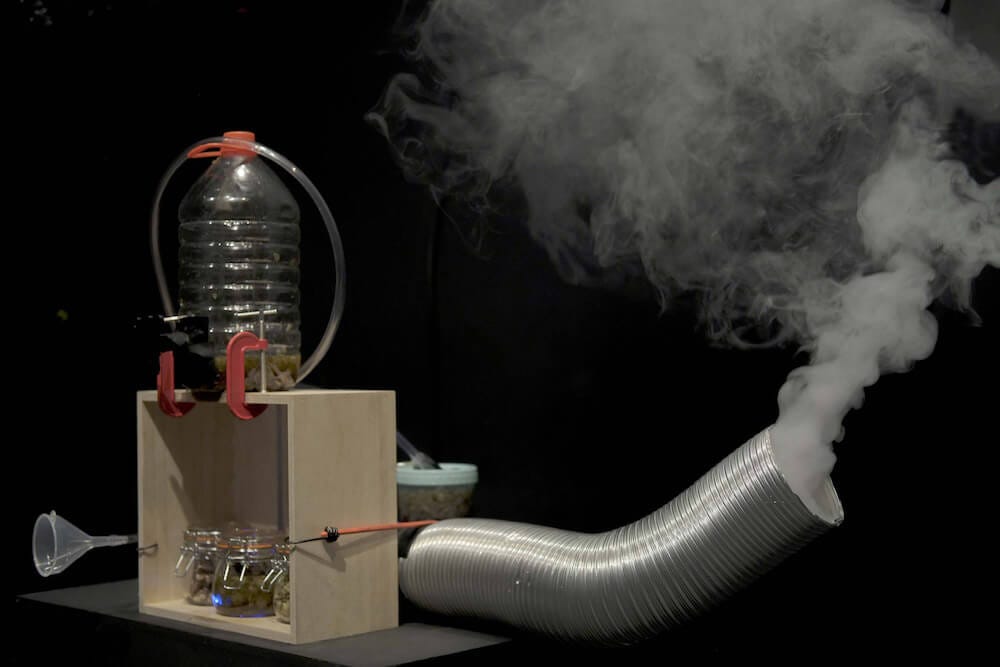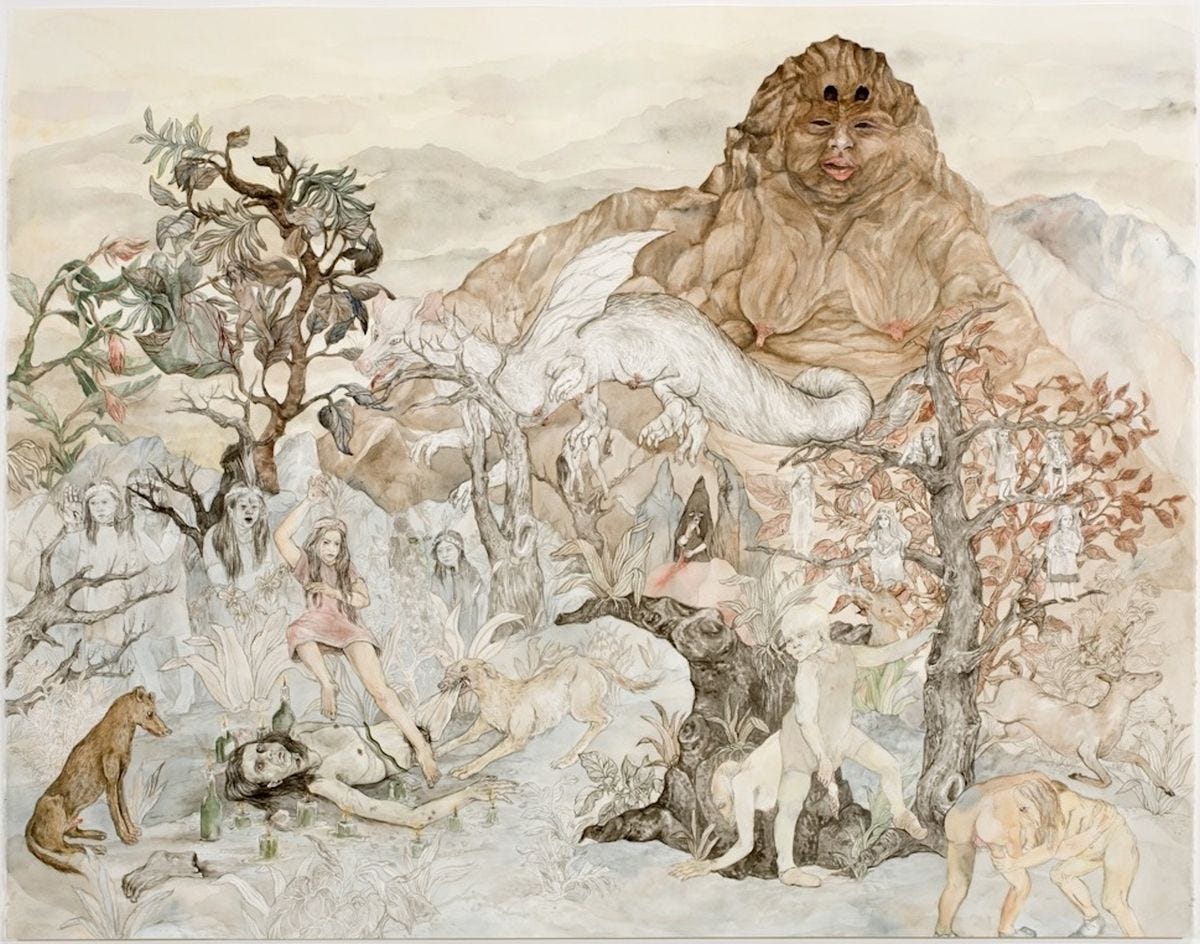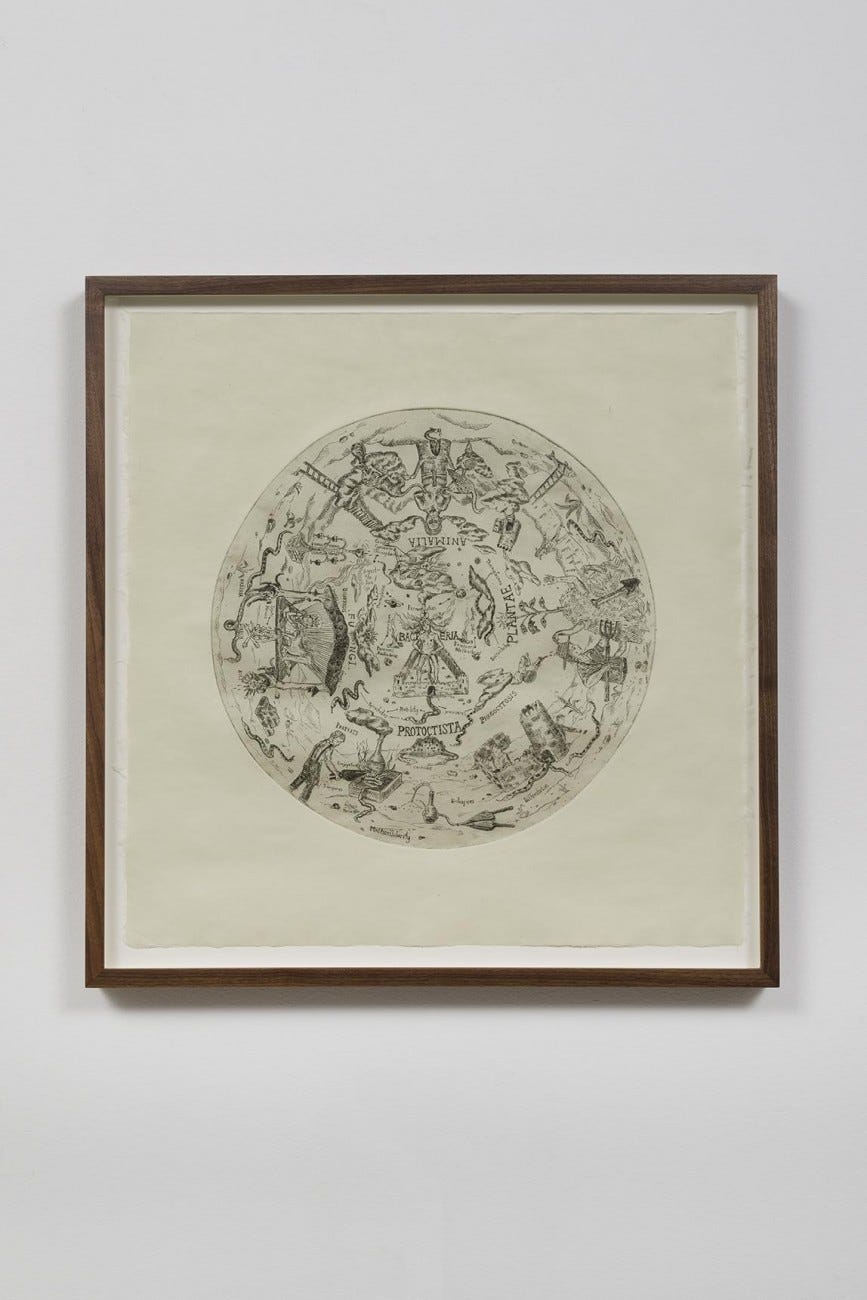1.
I released an alternate version of my track, Say No on Catalog. You can listen and/or purchase it here. Watch the original video here.
2.
I interviewed the artist Jared Madere for the Subject Object Verb podcast. We discussed his process of collaborating on music with Artificial Intelligence. You can listen here or on any podcast platform. I also interviewed Madere a few years back for Mousse, which, if you are hungry for more, you can read here.
3.
An interview with Candice Lin
Candice Lin once built a parasite large enough for a human to enter. She has distributed cigarettes filled with hormonally disruptive herbs, and in performance, has hot-boxed a van outside Vons in Echo Park with these same herbs. She used a fog machine to fill the Los Angeles gallery, Human Resources, with testosterone, disrupting the gender of anyone who enters the space. These are deep investigations of the ongoing conflict inside our own bodies—hormones, bacteria, worms. Born in the town where Thoreau inhabited Walden Pond, Lin sees social hierarchies of power—not transcendentalism—in the natural world. In an age when many are looking toward a digital post-human, Lin opens up humanity’s messy history of physiology, filled with its bitter healing plants, bacteria, cockroaches and dead baby mice, and puts it on display. Through provocative rituals, fetish objects and refined illustrations, Lin confronts us with the reality and conflict of our own wet, corporeal selves.
Why disrupt our hormones?
The recent work utilizing plants with hormonal properties is a collaborative project with my friend Patrick Staff. We were interested in thinking about ways in which herbalist books and news coverage of endocrine disruptors in the environment assumed this heteronormative and fixed idea around gender. A lot of the sources we were looking at used a language of fear or were geared toward achieving “normal balance” of hormones through plants. We were interested in questioning what a “normal balance” is and what the uses of herbal medicine might offer outside of that lens. In our DIY hacking impulses we are interested in where medical systems, commercial products and everyday materials can be utilized in ways that are not intended. There is a queer history of counter- reading texts, and so we applied this methodology to herbalist and botanical sources for our research.
What is the queer history of counter-reading texts?
Oh, by that I mean there is a kind of unofficial queer tradition of looking at archives, or family stories, or histories in which the official narrative might be that so-and-so lived as a spinster with a “companion” for many years, and in a queer counter-reading of this, the romantic or sexual partnership of the companion comes to the surface. Similarly, other kinds of texts can be read for their latent queer potential.
Have you taken any of these herbs yourself?
I made some clairvoyant testosterone, a hormonal tincture of herbs with gem essences of amethyst and quartz that I took everyday for six weeks. I noticed being more aware of and present to my libido. I noticed excretions from my body smelled differently and had a different consistency. I noticed an increase in my usual tragic flaw: impatience.
Do you use herbalism regularly in your life?
I have always been interested in herbs, since I was a child, and we would sometimes go to Chinese herbalist shops or receive or give gifts of herbs, like ginseng, or foods with medicinal properties, like sea cucumber or certain mushrooms. My parents were eager to have us assimilate to Western American culture, so they didn’t embrace Chinese medicine fully, but cultural aspects of it (like what foods to eat together and during what season, etc.), and common medicinal properties of herbs and foods (like seaweed or soups with dioscorea/yam, ginger, garlic, ginkgo nuts, goji berries, etc.) were forms of knowledge and edible medicines my parents unconsciously taught and gave to my sister and me. I incorporate herbalism into my life nowadays in a similar way, although I have made a concerted effort to read herbalist books and to learn more about the subject matter. It’s always been a fantasy of mine to really study it properly someday.
Your work usually draws on historical traditions. Where does history of herbalism fit into our culture? Where does it fit into your work?
Material and matter are really important aspects of my artistic practice and my teaching. I’m always thinking a lot about what it means to have a non-alienated relationship to the world, and I try to do that not only through reading and thinking about the histories of materials and their entwinement within human histories but also by a sensual engagement of materials and their properties and by tracing them to their roots. For example, making your own pigment by grinding minerals like malachite or insects like cochineal, or processing your own clay, or tasting your drawing or making your dinner or your fermented project into a sculpture.
I think about herbalism as one of many ways to think about a non- alienated relationship to the world, a way to think about our bodies in relationship to other species that share our molecules, our DNA, our viral roots. And I think that when we ingest plants or think about their liveliness and ability to change us, we remember that we are not self-enclosed individuals in a case but are enmeshed and porous, effected and effecting. The politics of this are important to remember in a lived and bodily way.This is something I try to engage in my work. I think you do as well in yours.
What are herbs to us now?
In our American, Westernized culture we have an alienated relationship to our environment that is about control, standardization, predictability. And this has led us to try to replicate herbs in a synthetic, reproducible way that alienates the plant as its own unique being with properties that are not controllable, fully knowable or replicable. It’s so easy for people educated in our narrow worldview to scoff at other forms of medicine or worldviews, but I think/hope this is shifting. And that is reflected in the dialogue opening up in the art world, where we use primarily white male Western OOO (object- oriented ontology) philosophers and the scientific language of quantum physics to open up and make ideas of entanglement, invisible energy that we cannot account for, the unknowingness and power of objects into concepts that are plausible and not laughable. But it’s funny to me that this just reveals how limited we still are, that we still need this kind of authoritative language to validate our thinking and can’t quite see how embedded this kind of thinking is in systems of power.
Would you say as a society that we fetishize history?
I guess you could say that histories reveal what qualities those in power who write history fetishize in their emphasis. My practice is research-based in a way that often looks at history, or rather what has slipped through the cracks of dominant history-telling, and tries to recover that in relationship to how I live the effects of history in the present and how that might be alive in a material physicality I’m cultivating in my studio.
Are you trying to tell an alternate history?
I think I’m more interested in an alternate present—a present that values curiosity and humility over mastery and that sees itself as accountable to and for, inextricably intertwined and alive to the vibrancy of the world.
Is “Orientalism” a problem you think about in your work—the idea of overly romanticizing other cultures?
Orientalism is something that I think about in my alignment within the world and in that way is present, perhaps indirectly, in the politics of my work. I love Sara Ahmed’s way of reading Edward Said’s Orientalism in relationship to her idea of “queer phenomenology” and thinking about what it means to distinguish between being “oriented toward” or “oriented around” and how these orientations structure how we think of power and subjectivity.
Are you trying to provoke people?
It’s funny because the issue of horror, disgust or shock often comes up in relationship to my work, but I don’t intend for my work to elicit those feelings and sometimes even have a hard time seeing how that would be the reaction, I guess because I’m the maker of it, and I’m too close to it. Materials that I cultivate or gather together are things I am attracted to—aesthetics that I find sensual, vibrant, appealing. Perhaps subject matter that seems taboo or materials like slimy bacteria or fuzzy molds have this allure in part because they are charged with transgressive power.
Listen to Candice Lin’s audio piece about a beloved feral cat on Subject Object Verb here.
I got bored, made up a goal
Sold my gun, part of my soul
But that was wrong of me to do
Goals don't happen to people like me and you
Show me that roof and i’ll show you my new floor
Say no
Leave goals alone
I had fun making a goal
Gave my time, gave up control
But that was wrong of you to do
It’s why you need to change your view
Show me that roof and i’ll show up my new floor
Say no
Leave goals alone











